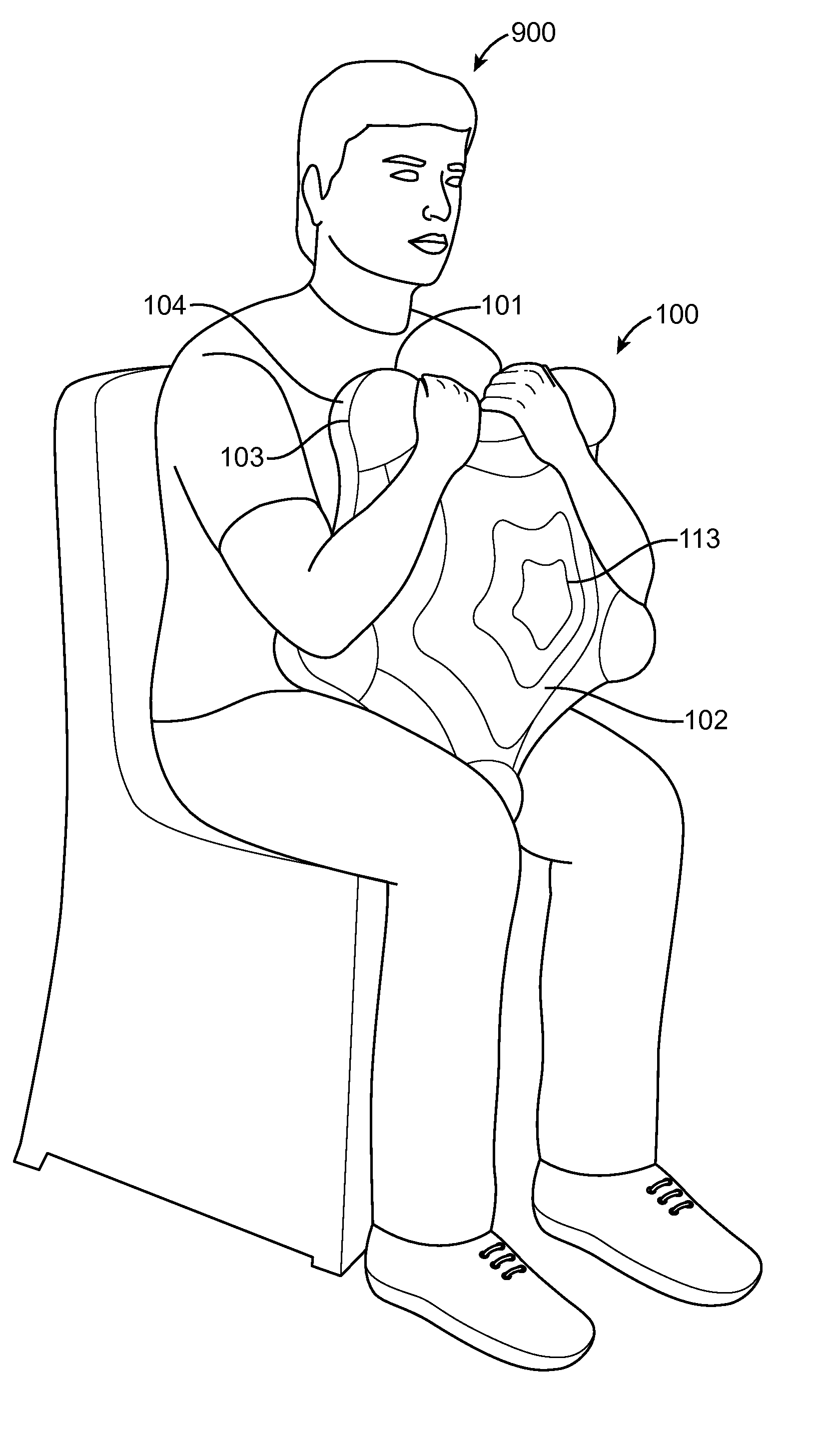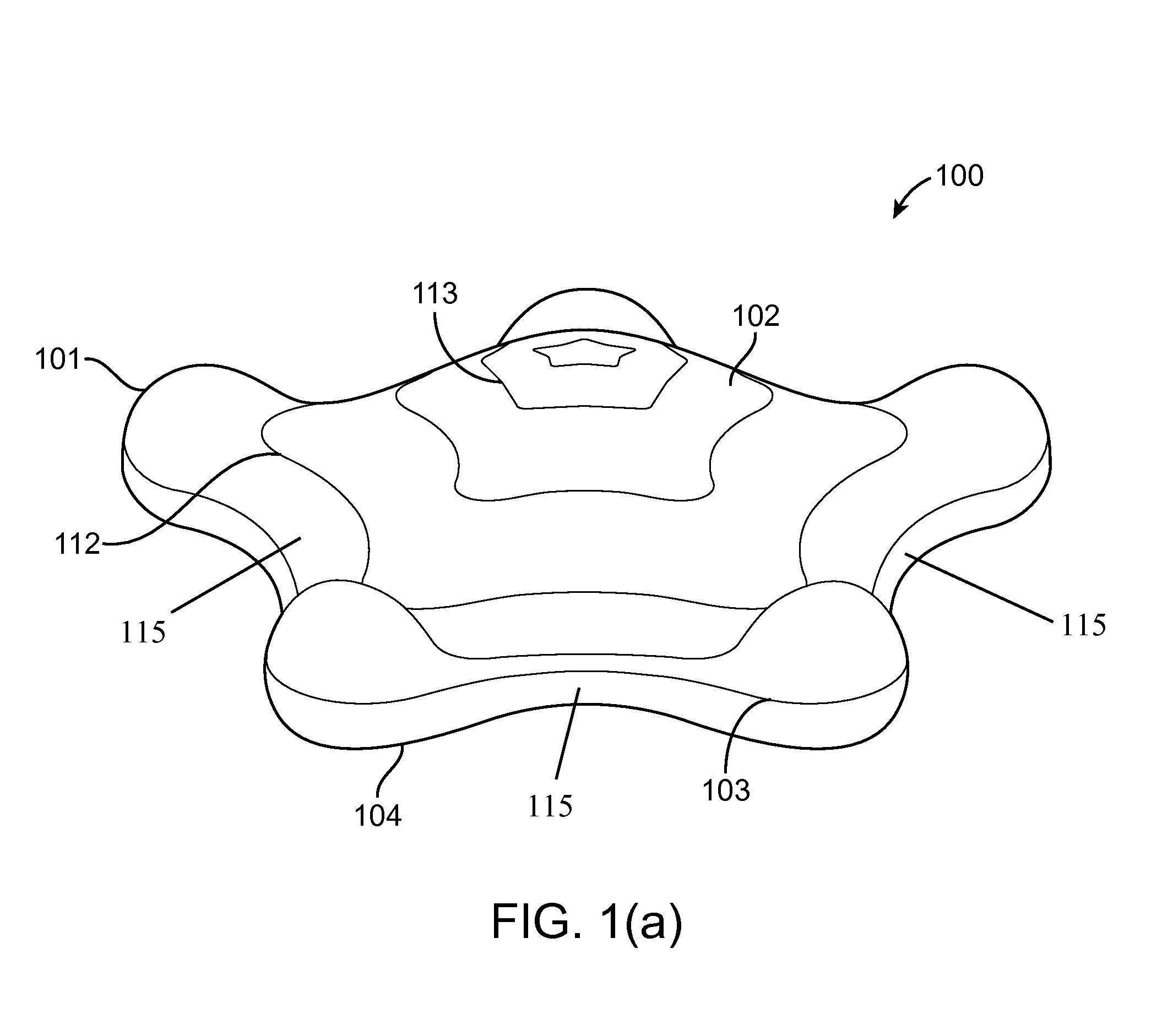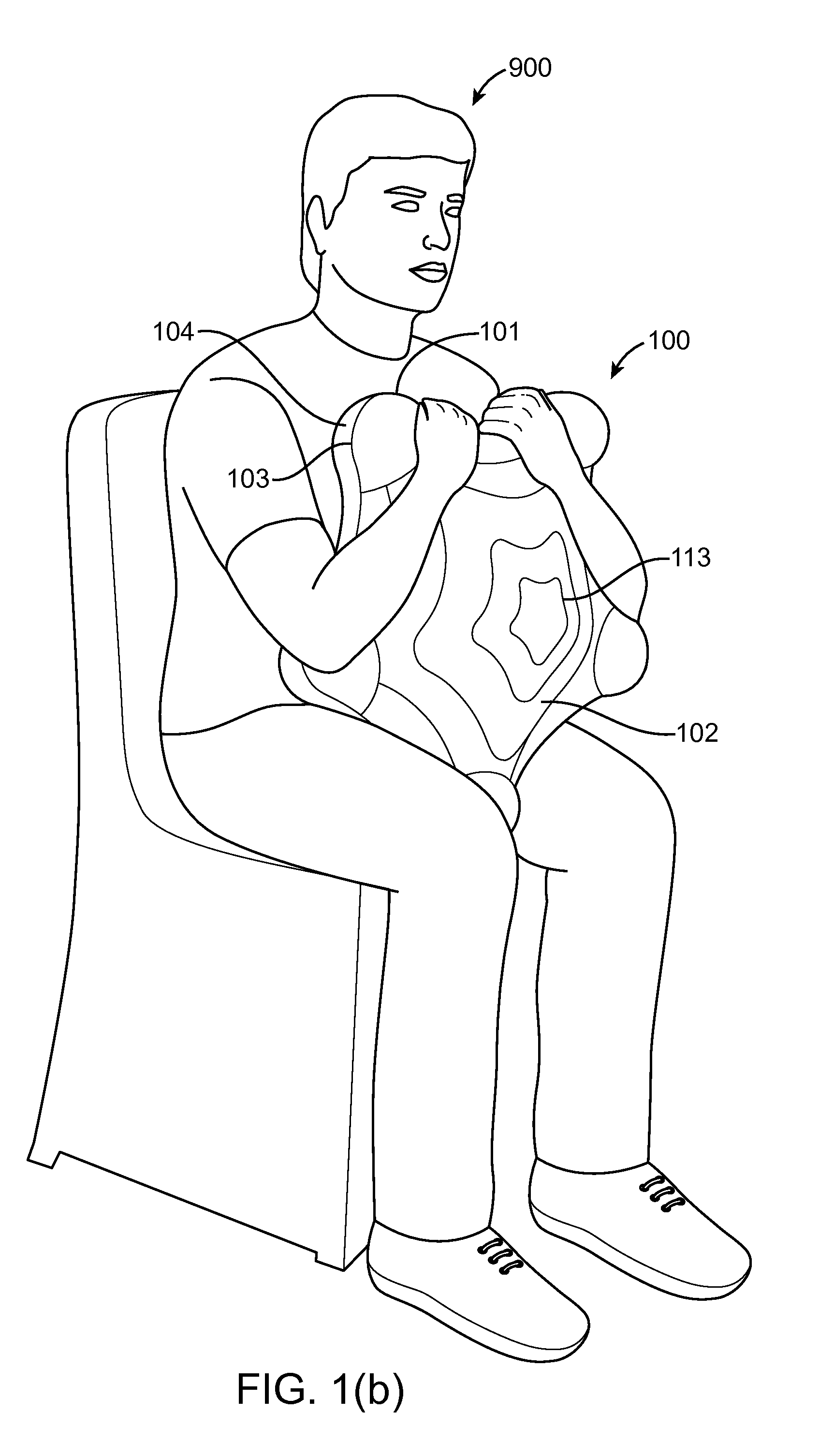The problems of a person performing sit-ups and / or crunches without the assistance of any other device are well known in the related art and result in at least four problems.
The first problem associated with traditional sit-ups and crunches is the problem of even getting into a reclined or
supine position on the floor.
For many people the floor location and getting into such a supine or reclined position on the floor is problematic.
For example,
elderly people can have difficulty in getting into a reclined or
supine position on the floor and then transitioning back again off the floor from such a position.
The second problem that traditional sit-ups and crunches create is a possibility of stress, strain, discomfort, and pain in the lower back region because the lower back region is not supported when doing traditional sit-ups and crunches.
A third problem that traditional sit-ups and crunches create is a possibility of stress, strain, discomfort, and pain in the neck because while the sit-ups or crunches are being performed gravity continually pulls upon the person's head which can cause stress, strain, discomfort, and pain in the neck region.
In addition,
headaches are also a common problem
stemming from an unsupported head during sit-ups and / or crunches exercises.
And a fourth problem arises because as a person becomes more in-shape, i.e. in better physical condition, the person must perform increasingly more repetitions of sit-ups and / or crunches to properly exercise the now stronger
abdominal muscles which becomes
time consuming.
This occurs because the resistance which generates the
abdominal exercise in sit-ups and crunches is merely the weight of the person performing the exercise acting against gravity and thus the effectiveness of traditional sit-ups and crunches are limited by the person's own
body weight, unless some artificial weights are added or some form of increased resistance beyond a person's own
body weight is provided.
Each these categories of related art has introduced new problems or failed to alleviate the four problems associated with traditional sit-ups and crunches.
First, consider
breathing exercise devices, which do not fit into the three broad categories of related art noted above and represents an
outlier in the related art.
Breathing exercise devices do not solve the fundamental problem of exercising
abdominal muscles by performing repeated exercises against some resistance.
However, these machines where the user is supine do not generally address the problem of lower
back pain because in most of these machines there is no specific lower
back support; that is, the supporting bench which may support the
buttocks region and upper back region has no contour to support the curve of the lower back.
In contrast, in these large
abdominal exercise machines where the user is kneeling upon the user's knees the problem of
neck pain persists because the user's head in not supported in such machines where the user is kneeling.
However, this category of machines where the user is kneeling do tend to alleviate the problems associated with lower
back pain and the problem of getting into a supine or reclined position on the floor.
However, all of the large
abdominal exercise machines as a category, whether a user is supine, kneeling, sitting, or standing, introduce the following four new undesirable problems: complexity, bulkiness, immobility, and excessive expense.
First, the machines are complex in the sense they have
moving parts and adjustments to make to set-up and operate the machines (such as changing weights or elastic bands).
Moving parts are not desirable because they often create safety problems.
For example, moving parts often create geometry where a user may get pinched, have hair get caught or even have fingers and toes crushed by moving weights.
Additionally, in general, as the number of moving parts increases there is a correlated increase in maintenance and
longevity problems with machines With respect to moving parts and adjustments, consider back inversion machines which require a user to first make a
size adjustment to the
machine to accommodate the height of the user, then the user straps their feet into the
machine securely, then the user rotates so the user is hanging upside down, and finally then the user at that point can perform inverted sit-ups.
Furthermore some required adjustments in the related art actually require a user to be secured to the device, which can present an undesirable safety
hazard (e.g. a user can get stuck in a device) or result in the user feeling claustrophobic.
Second, because the machines are large in comparison to a user, they are bulky often having a large framework to support both the
machine and the user.
Because of this bulkiness, the locations where such a machine can be located are limited.
Further because of this bulkiness, it may be difficult to even install such a large machine into a location the user would prefer.
For example, doorways and
stairs can present installation problems.
Third, also because of these machines
large size, complexity, and bulkiness, the machines are not mobile for most users.
That is, this category of large abdominal exercise machines lacks portability.
The portability problem in the art is related to two other problems: safety from dropping and breakage from dropping.
Conversely, many non-portable devices can injure a user if dropped and can break if dropped, both undesirable problems in the art.
Lastly, such large machines tend to be expensive in comparison to other alternatives, costing several hundred to thousands of U.S. dollars.
However, these electrical muscle stimulating devices have four other problems.
First, they tend to be more expensive than other abdominal exercise alternatives such as the simpler abdominal exercise devices discussed below.
Second, many users are not comfortable with the sensations created when an electrical muscle stimulating device electrically stimulates a user's muscles without the user consciously intending to exercise the given muscle.
Thirdly, these devices because they are electrical require a power source, either by plugging the device into an electrical outlet which limits mobility or via batteries which also have a limited useful charge.
The diversity of settings and adjustments make use comparatively complex and less than desirable for the average
consumer.
These EMG devices do not provide any
resistance training for muscles and thus do not solve the fundamental problem of exercising abdominal muscles by performing repeated exercises against some resistance.
However, because these simpler devices have lost the support framework associated with the larger abdominal exercise machines many of these simpler devices must be utilized on the floor from the supine and / or reclined position or were intentionally designed to be used from the floor and thus have the first problem of traditional sit-ups and crunches, the problem that for some users the floor location is undesirable or exercising from a supine or reclined position on the floor is undesirable.
Additionally, while this category of simpler abdominal exercise devices generally has less moving parts than the counter-part category of large abdominal exercise machines, many of these simpler devices still contain moving parts and thus present a degree of complexity to the user where it would be desirable to reduce this degree of complexity by reducing the number of moving parts.
However, such spherical or half-sphere devices do have movement during their normal use because of how a user interacts with the curved geometrical surfaces and because the materials of construction and design permit elastic contraction and rebound.
While such spherical or half-sphere devices are simpler in the sense they have no moving parts, they are actually difficult to master because of the fine balance required to exercise upon a curved geometrical surface with elastic properties that readily moves in response to the slightest shifts in a user's weight.
For example, exercising while balancing upon a ball or even half-ball with a
diameter in the one to four feet range is generally a difficult task for the average
consumer.
Additionally, these spherical and half-sphere devices are utilized from the floor location and thus have the first problem of traditional sit-ups and crunches, the problem that for some users have trouble getting into and out of the supine and / or reclined position on the floor.
Additionally, the related art category of simpler abdominal devices generally does not alleviate the problem of having to make adjustments to set-up and / or use the abdominal exercise device in question.
The first four problems are the problems associated with traditional sit-ups and crunches, which are: (1) a user having difficulty in getting into a supine and / or reclined position on the floor; (2) problems of lower
back pain due to a lack of lower
back support; (3) problems of
neck pain and
headaches due to a lack of head support; and (4) available resistance being limited to a user's own weight.
A fifth problem is the problem of undesirable complexity.
Complexity may arise because of moving parts and / or because of the need to make adjustments to set-up and use the device in question.
Complexity also results in safety concerns as discussed above.
A sixth problem is that of bulkiness.
This problem limits the location of where a device may be used or even in getting the device into a desired location.
A seventh problem is one of portability.
An eighth problem is one of expense.
And lastly, there is the group of problems associated with the electrical muscle stimulating devices, i.e. the problem of a user having to get used to the electrical pulses and having unconscious muscle contractions, along with the typical problems that electrical device present of needing electrical power to operate.
 Login to View More
Login to View More  Login to View More
Login to View More 


